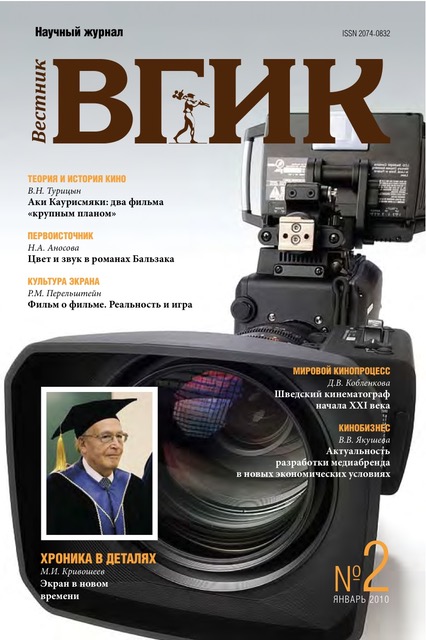Color and Sound in Balzac's Novels
- Authors: Anosova N.A.1, Anosovа N.A.1
-
Affiliations:
- Issue: Vol 2, No 1 (2010)
- Pages: 66-83
- Section: ORIGINAL SOURCE | DRAMATURGY OF GENRE
- URL: https://journals.eco-vector.com/2074-0832/article/view/15091
- DOI: https://doi.org/10.17816/VGIK2166-83
- ID: 15091
Cite item
Full Text
Abstract
This paper analyzes the dramatic color of Honore de Balzac's novels "Shagreen" (1831) and "Father Goriot" (1834). Using symbolic colors, different color details and motives, color and light accents, decoloration Balzac creates dramatic contrasts, transforms the time, reveals the inner state of the characters. The writer's works are the result of the brilliant application of the reflex theory to literature suggested by Eugene Delacroix, a painter and Balzac's contemporary.
Artistic intensity and the diversity of color elements in Balzac's novels are one of the vivid steps on the way to the chromatic and not just color cinema as Eisenstein wrote. The correlation of prose and film was one of the main subjects of Nina Anosova's research. A talented literary and film scholar and teacher, a Moscow Institute of Philosophy, Literature and Histroy Institute (IFLI) graduate, she spent over 55 years teaching at VGIK. Such prominent filmmakers as Marlene Khutsiev, Andrei Tarkovsky, Vasily Shukshin, Gennady Shpalikov, Yuri Arabov, Karen Shakhnazarov, Vadim Abdrashitov, Sergey Loznitsa, etc. were among her pupils. The students and graduates of the Institute of Cinematography constantly turn to her works, learning real (deep) analysis and understanding of literature and art.
Artistic intensity and the diversity of color elements in Balzac's novels are one of the vivid steps on the way to the chromatic and not just color cinema as Eisenstein wrote. The correlation of prose and film was one of the main subjects of Nina Anosova's research. A talented literary and film scholar and teacher, a Moscow Institute of Philosophy, Literature and Histroy Institute (IFLI) graduate, she spent over 55 years teaching at VGIK. Such prominent filmmakers as Marlene Khutsiev, Andrei Tarkovsky, Vasily Shukshin, Gennady Shpalikov, Yuri Arabov, Karen Shakhnazarov, Vadim Abdrashitov, Sergey Loznitsa, etc. were among her pupils. The students and graduates of the Institute of Cinematography constantly turn to her works, learning real (deep) analysis and understanding of literature and art.
About the authors
Nina Aleksandrovna Anosova
Nina Alexandrovna Anosovа
literary critic, film scholar and teacher. A graduate of the Moscow Institute of Philosophy, Literature and History (the institute), she taught World Literature in VGIK for over 55 years
References
Supplementary files








